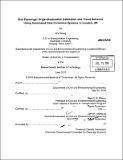| dc.contributor.advisor | Nigel H.M. Wilson and John P. Attanucci. | en_US |
| dc.contributor.author | Wang, Wei, S.M. Massachusetts Institute of Technology | en_US |
| dc.contributor.other | Massachusetts Institute of Technology. Dept. of Civil and Environmental Engineering. | en_US |
| dc.coverage.spatial | e-uk-en | en_US |
| dc.date.accessioned | 2011-01-26T14:28:58Z | |
| dc.date.available | 2011-01-26T14:28:58Z | |
| dc.date.copyright | 2010 | en_US |
| dc.date.issued | 2010 | en_US |
| dc.identifier.uri | http://hdl.handle.net/1721.1/60814 | |
| dc.description | Thesis (S.M. in Transportation)--Massachusetts Institute of Technology, Dept. of Civil and Environmental Engineering, 2010. | en_US |
| dc.description | Cataloged from PDF version of thesis. | en_US |
| dc.description | Includes bibliographical references (p. 105-106). | en_US |
| dc.description.abstract | This research explores the application of archived data from Automatic Data Collection Systems (ADCS) to transportation planning with a focus on bus passenger Origin-Destination (OD) inferences at the bus-route level and on travel behavior, using London as an example. This research demonstrates the feasibility and ease of applying the trip-chaining method to infer bus passengers' boarding and alighting locations, and validates the results by comparing them with the Bus Passenger Origin and Destination (BODS) survey data in London. With the inferred OD matrices, the variations of weekday and weekend bus route OD patterns over a two-week period are examined for planning purposes. Given these variations, reliance on ADCS can provide transit planners with more comprehensive, reliable and correct information for service planning than traditional manual surveys. Moreover, while interchange conditions and performance are considered important inputs for public transit planning, collecting such data has not been easy. Based on the inferred OD matrices and the Automatic Vehicle Location (AVL) data, alighting times for bus passengers can also be estimated. As a result, bus journey stages can easily be linked to form complete journeys based on the difference between the subsequent trip's boarding time and the previous trip's alighting time for each bus passenger. By comparing the interchange time and the connecting bus route's headway, this research also provides a way to evaluate connecting bus services and bus passengers' interchange patterns. Finally, this research can be expanded to the full bus network and other travel modes, opening the door to developing more comprehensive data bases for use in intermodal network planning. | en_US |
| dc.description.statementofresponsibility | by Wei Wang. | en_US |
| dc.format.extent | 130 p. | en_US |
| dc.language.iso | eng | en_US |
| dc.publisher | Massachusetts Institute of Technology | en_US |
| dc.rights | M.I.T. theses are protected by
copyright. They may be viewed from this source for any purpose, but
reproduction or distribution in any format is prohibited without written
permission. See provided URL for inquiries about permission. | en_US |
| dc.rights.uri | http://dspace.mit.edu/handle/1721.1/7582 | en_US |
| dc.subject | Civil and Environmental Engineering. | en_US |
| dc.title | Bus passenger origin-destination estimation and travel behavior using automated data collection systems in London, UK | en_US |
| dc.type | Thesis | en_US |
| dc.description.degree | S.M.in Transportation | en_US |
| dc.contributor.department | Massachusetts Institute of Technology. Department of Civil and Environmental Engineering | |
| dc.identifier.oclc | 696215219 | en_US |
